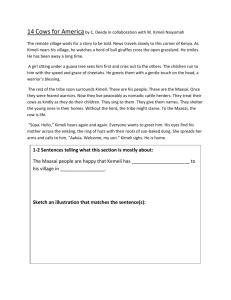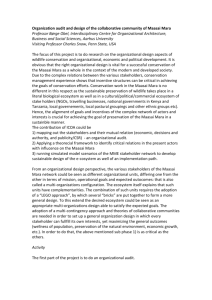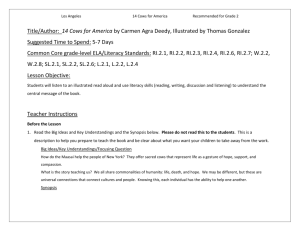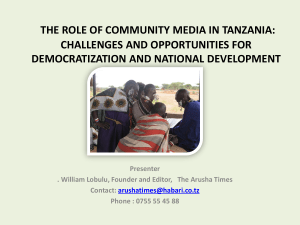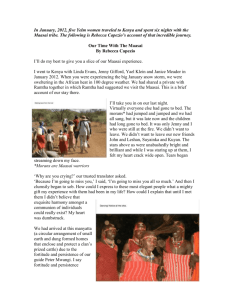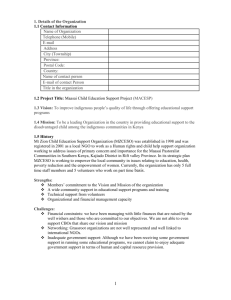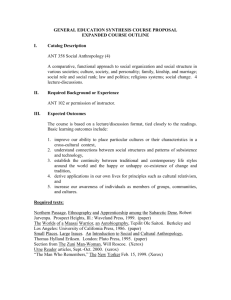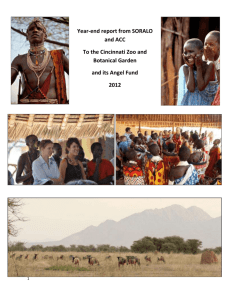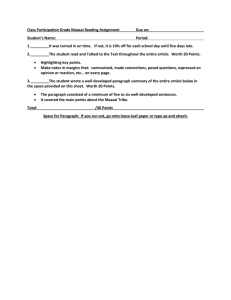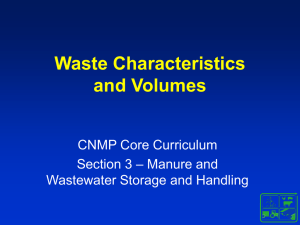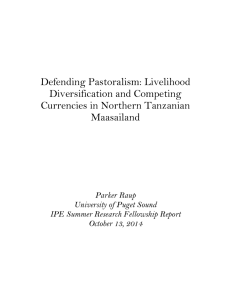3.5 Food Resources
advertisement
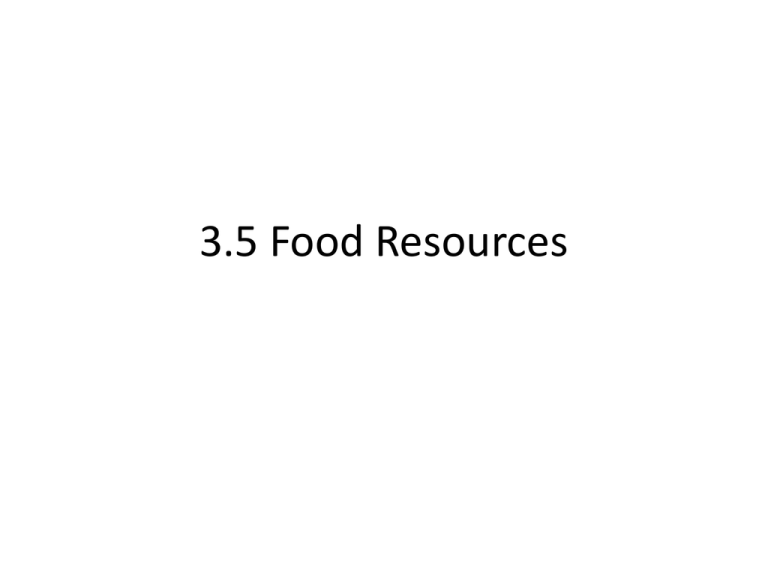
3.5 Food Resources Outline the issues involved in the imbalance in global food supply. • Click on the image below to go to the website containing this Powerpoint presentation Lrabbetts (November 2007) - http://www.slideshare.net/lrabbetts Compare and contrast the efficiency of terrestrial and aquatic food production systems • Arable We eat the Producers so little energy is lost through transitions between trophic levels in the food chain. • Livestock We eat Consumers that have eaten Producers. About 90% Energy is lost in each trophic level transfer. • Fisheries Many of the fish we eat are 2ndary , 3ary or 4ary consumers. Also 1ary productivity of the seas is lower than land due to water absorbing much of the energy. This leads to much lower efficiency. Compare and contrast the inputs and outputs of materials and energy (energy efficiency), The system characteristics, and evaluate the relative environmental impacts of 2 named food production systems Intensive Beef Farming USA: Subsistence Beef Farming Tanzania: 5. System characteristics High population density High inputs to gain high profits per unit area. Nomadic, organic 6. Environmental impact Energy, oil and water consumption is nonsustainable. Generally sustainable, Possibility of over grazing. 1. Inputs of materials 2. Inputs of energy 3.Outputs of materials 4. Outputs of energy USA Inputs Energy… 1. . 2. . 3. . 4. . 5. . Energy… 1. . 2. . 3. . 4. . 5. . Materials… 1. . 2. . 3. . 4. . 5. . Materials… 1. . 2. . 3. . 4. . 5. . Tanzania USA Outputs Energy… … 1. . 2. . 3. . 4. . 5. . Energy… … 1. . 2. . 3. . 4. . 5. . Materials… 1. Water. 2. . 3. . 4. . 5. . Materials… 1. . 2. . 3. . 4. . 5. . Tanzania System Characteristics - USA Factory farms hold large numbers of animals, typically cows, pigs, turkeys, or chickens, often indoors, typically at high densities. The aim of the operation is to produce as much meat, eggs, or milk at the lowest possible cost. Food is supplied in place, and a wide variety of artificial methods are employed to maintain animal health and improve production, such as the use of antimicrobial agents, vitamin supplements, and growth hormones. Physical restraints are used to control movement or actions regarded as undesirable. Breeding programs are used to produce animals more suited to the confined conditions and able to provide a consistent food product. The distinctive characteristic of factory farms is the intense concentration of livestock. At one farm (Farm 2105) run by Carrolls Foods of North Carolina, the second-largest livestock producer in the U.S., twenty animals are kept per pen and each confinement building holds 25 pens.[22] The company's chief executive officer, F.J. "Sonny" Faison, has said: "It's all a supply-anddemand price question … The meat business in this country is just about perfect, uncontrolled supply-anddemand free enterprise. And it continues to get more and more sophisticated, based on science. Only the least-cost producer survives in agriculture."[23] http://en.wikipedia.org/wiki/Factory_ farming#cite_note-Scully259-21 “They're in state-of-the-art confinement facilities. The conditions that we keep these animals in are much more humane than when they were out in the field. Today they're in housing that is environmentally controlled in many respects. And the feed is right there for them all the time, and water, fresh water. They're looked after in some of the best conditions, because the healthier and [more] content that animal, the better it grows. So we're very interested in their well-being—up to an extent.”[24] F.J. "Sonny" Faison, Carrolls Foods of North Carolina Image http://en.wikipedia.org/wiki/File:Confined-animalfeeding-operation.jpg Cows in a factory farm in the U.S. 22. Scully, Matthew. Dominion, St. Martin's Griffin, pp. 259. 23. Scully, Matthew. Dominion, St. Martin's Griffin, 2002, pp. 255–256. 24. Scully, Matthew. Dominion, St. Martin's Griffin, 2002, p. 258. System Characteristics - Tanzania Maasai men and boys herding cattle. Notice the ‘Hump’ on the cows haunches – this is a fatty water storage organ that makes the cows drought resistant. • Cows are more valuable than women! Cows are used for ceremonial purposes. They are not killed for their meat but are bled and milked; the milk and blood are mixed with a little acid to make it curdle to provide food. • Nomadic lifestyle. Herds are moved from watering hole to watering hole. The Maasai move their ‘Bomas’ (mobile villages) with the herds. When one area is grazed out they move on. Maasai are able to supplement their diet with wild root vegetables and wild fruits. Many Maasai are now becoming non-nomadic but still farm beef cows. http://i.telegraph.co.uk/multimedia/archive/01209/maasai_1209462c.jpg Environmental Impacts –USA– Wikipedia Concentrating large numbers of animals in factory farms is a major contribution to global environmental degradation, through the need to grow feed (often by intensive methods using excessive fertiliser & pesticides), pollution of water, soil and air by agrochemicals and manure waste, & use of limited resources (water, energy).[57] Livestock production is also particularly water-intensive in indoor, intensive systems. 8% of global human water use goes towards animal production, including water used to irrigate feed crops.[57] The animals are generally kept on concrete with slats or grates for the manure to drain through. The manure is usually stored in slurry form (slurry is a liquid mixture of urine & faeces). During storage on farm, slurry emits methane & when manure is spread on fields it emits nitrous oxide & causes nitrogen pollution of land & water. (Organic meat production has a lower global warming potential per kg than does intensive meat production.) “I’m really worried about this ‘Mad Cow’ disease” “I’m not; I’m a Environmental impacts of factory farming can include: squirrel” • Deforestation for animal feed production • Unsustainable pressure on land for production of high-protein/high-energy animal feed • Pesticide, herbicide and fertilizer manufacture and use for feed production • Unsustainable use of water for feed-crops, including groundwater extraction • Pollution of soil, water and air by nitrogen and phosphorus from fertiliser used for feed-crops and from manure • Land degradation (reduced fertility, soil compaction, increased salinity, desertification) • Loss of biodiversity due to eutrophication, acidification, pesticides and herbicides • Worldwide reduction of genetic diversity of livestock and loss of traditional breeds • Species extinctions due to livestock-related habitat destruction (especially feed-cropping) http://en.wikipedia.org/wiki/Factory_farming Environmental Impacts - Tanzania The Maasai live in marginal lands. The extra burden of the cattle herds on an already poor soil conditions can be immense . 1. In drought there is a tendency to overgrazing leading to soil degradation by erosion. As the Maasai are constantly moving the overgrazing can be spread over a large area. However the constant movement also allows the soil recovery time (normally 3 months) before the next grazing period. 2. Lack of agrochemicals means that Nomadic beef farming is completely organic, limiting chemical degradation. Manure from herd adds nutrients to the soils. 3. Competition with wild-life. The herds directly compete for resources (food, water….) with herbivores in the marginal lands. 4. Maasai protect their herds against predators. There have been numerous conflicts over the years between Maasai herdsmen and animal conservation organisations. For further reading go to: http://www.maasai-association.org/opinion.html#human Vadim Onishchenko – Wildlifephoto.org http://www.wildlife-photo.org/catalog_old/africantribeimages/masaikid-drink-milk-and-blood-avkj7t0545-out.jpg Discuss the links that exist between social systems and food production systems


